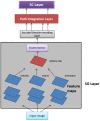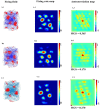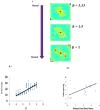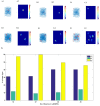Saccade Velocity Driven Oscillatory Network Model of Grid Cells
- PMID: 30687054
- PMCID: PMC6335253
- DOI: 10.3389/fncom.2018.00107
Saccade Velocity Driven Oscillatory Network Model of Grid Cells
Abstract
Grid cells and place cells are believed to be cellular substrates for the spatial navigation functions of hippocampus as experimental animals physically navigated in 2D and 3D spaces. However, a recent saccade study on head fixated monkey has also reported grid-like representations on saccadic trajectory while the animal scanned the images on a computer screen. We present two computational models that explain the formation of grid patterns on saccadic trajectory formed on the novel Images. The first model named Saccade Velocity Driven Oscillatory Network -Direct PCA (SVDON-DPCA) explains how grid patterns can be generated on saccadic space using Principal Component Analysis (PCA) like learning rule. The model adopts a hierarchical architecture. We extend this to a network model viz. Saccade Velocity Driven Oscillatory Network-Network PCA (SVDON-NPCA) where the direct PCA stage is replaced by a neural network that can implement PCA using a neurally plausible algorithm. This gives the leverage to study the formation of grid cells at a network level. Saccade trajectory for both models is generated based on an attention model which attends to the salient location by computing the saliency maps of the images. Both models capture the spatial characteristics of grid cells such as grid scale variation on the dorso-ventral axis of Medial Entorhinal cortex. Adding one more layer of LAHN over the SVDON-NPCA model predicts the Place cells in saccadic space, which are yet to be discovered experimentally. To the best of our knowledge, this is the first attempt to model grid cells and place cells from saccade trajectory.
Keywords: grid cells; hippocampus; oscillator; principal component analysis-PCA; saccades; salience map.
Figures









Similar articles
-
A unified hierarchical oscillatory network model of head direction cells, spatially periodic cells, and place cells.Eur J Neurosci. 2018 May;47(10):1266-1281. doi: 10.1111/ejn.13918. Epub 2018 Apr 16. Eur J Neurosci. 2018. PMID: 29575125
-
Modeling the Effect of Environmental Geometries on Grid Cell Representations.Front Neural Circuits. 2019 Jan 14;12:120. doi: 10.3389/fncir.2018.00120. eCollection 2018. Front Neural Circuits. 2019. PMID: 30692918 Free PMC article.
-
Extracting grid cell characteristics from place cell inputs using non-negative principal component analysis.Elife. 2016 Mar 8;5:e10094. doi: 10.7554/eLife.10094. Elife. 2016. PMID: 26952211 Free PMC article.
-
The role of the parietal cortex in the neural processing of saccadic eye movements.Adv Neurol. 2003;93:141-57. Adv Neurol. 2003. PMID: 12894406 Review.
-
Environmental boundaries as a mechanism for correcting and anchoring spatial maps.J Physiol. 2016 Nov 15;594(22):6501-6511. doi: 10.1113/JP270624. Epub 2016 Jan 5. J Physiol. 2016. PMID: 26563618 Free PMC article. Review.
References
-
- Akdogan I., Unal N., Adiguzel E. (2011). Estimation of the number of neurons in the hippocampus of rats with penicillin induced epilepsy. Image Analysis Stereology 21:117 10.5566/ias.v21.p117-120 - DOI
-
- Andersen P., Morris R., Amaral D., Bliss T., Keefe O.'J. (2009). The Hippocampus Book. Oxford: Oxford University Press.
LinkOut - more resources
Full Text Sources

